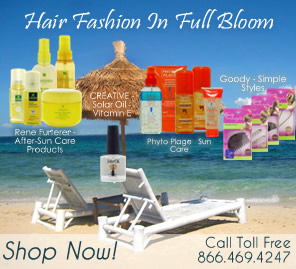|
||||||||||
 |
|
| September 03, 2013 | To ensure delivery of this email, please add newsletter@hairboutiquemedia.com to your contacts. |
Showcasing Wurly Styles  This Week's 20% Off Coupon: SULTRYSEPTEMBER20 Sometimes the curls stay hidden at the nape of the neck, like my own hair. Other times they pop up around the hairline, along the top of the head or at random points. Wurly hair can be fine/thin, medium or thick. Wurly hair can be straight on top, wavy throughout the middle and curly underneath or vice versa. When someone has hair which is neither straight, strictly curly or wavy, it is often referred to as wurly. Sometimes curl embellished waves are known as wurls. Just as every type and texture of hair have their own care and styling needs, the same can be said for wurly hair. When the ideal hair care and styling techniques are applied to wurls, the results are beautiful pops of spirals, well placed kinks and coils and loose fat waves. Start With A Great Cut The key to great wurly hair is to decide whether you wish to amp up the waves and intermingle curls, amp up curls instead of the waves or go for a completely intregrated look. Work with a hairstylist who understands wurls for an ideal haircut which addresses the different textures throughout your hair. The ideal cut makes the difference in making wurly hair look good while growing it out. Sometimes layers carefully carved into the texture will help. Listed below are some general hair care, color and styling tips for wurly hair: Cleansing Wurly hair tends to have the same dryness challenges as more tightly curled or coiled hair. This means that wurls needs moisture, moisture, moisture. 1. Cleanse only when necessary. 5. Rinse well after cleansing and apply a rinse-out conditioner from the ears down to the ends. Detangle hair while in the shower working in small horizontal sections using a wide tooth comb or fingers. Styling 1. Towel blot – don’t rub – wet hair. Depending on your end goals you may wish to try plopping which helps form ringlets and curls. Wet bunning wrapped to amp up waves is an ideal option to show off those loose ribbons. Methods like plopping, scrunching or twirling wurly strands can help enhance the texture in some, but not all cases. Some things that often help are cleansing with the Conditioner Only Method which really helps tone down frizziness. It also helps to avoid touching the hair while it’s drying while using products to enhance the texture. Hair Color 1. When highlights and low lights are applied properly they look spectacular on wurly hair. With wurly hair it’s best to avoid changing the overall color more than 1-2 shades because the lines of demarcations can show very prominently, especially with longer hair. Ideally highlights and low lights should be randomly applied to the hairline and throughout the interior to create a natural burst of color without danger of damages. Other Wurly Hair Tips Many wurlies do not comb or brush strands after drying due to the fact hair may get horribly poufy. Other people with wurly strands will finger pick to arrange their strands. Summary If your hair never dries or falls straight without blowdrying or flat-ironing you fall into the wurly hair category. For people who follow the Andre Walker hair classification system you would fall into the 2 category. Or wurly hair might be classified as 2c/3a. Ultimately wurly hair requires discovering the best hair cut, style, care and products which work best for your own hair type, texture, length and condition. Images courtesy Tom Carson |
| If you would like to consult with Karen personally about any of your health and beauty questions, please see our Ask Karen page. |
 |
 |
 |
 |
 |
 |
| Copyright 1997-2011, hairboutique.com, All Rights Reserved. Terms of Service, Privacy Statement, Advertise, Contact Us, Press |
| Please note that you are receiving this mail because in the past you signed up for the HairBoutique.com mailing list. This mailing is in full compliance with U.S. Federal requirements for commercial e-mail under bill s.1618 Title 111, Section 301, Paragraph (a) (2) (c) passed by the 105th U.S. Congress. |




